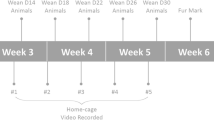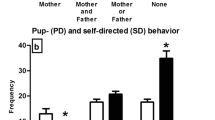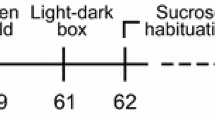Abstract
The interaction between genotype and environment is an important feature of the process of development. We investigate this interaction by examining the influence of postnatal cross-fostering and post-weaning cross-housing on the behavioral development of 129S and B6 mice. Following cross-fostering, we found significant alterations in the frequency of maternal care as a function of maternal strain and pup type as well as interactions between these variables. In adulthood, we find there are sex-specific and strain-specific alterations in anxiety-like behavior as a function of rearing environment, with males exhibiting more pronounced rearing-induced effects. Mixed-strain housing of weanlings was found to lead to alterations in home-cage social and feeding behavior as well as changes in adult anxiety-like responses of 129S mice. Anxiety-like behavior in B6 mice was altered as a function of the interaction between housing condition and weaning weight. These data illustrate the complex pathways through which early and later social experiences may lead to variations in behavior.



Similar content being viewed by others
References
Abramov U, Puussaar T, Raud S, Kurrikoff K, Vasar E (2008) Behavioural differences between C57BL/6 and 129S6/SvEv strains are reinforced by environmental enrichment. Neurosci Lett 443:223–227
Alleva E, Caprioli A, Laviola G (1989) Litter gender composition affects maternal behavior of the primiparous mouse dam (Mus musculus). J Comp Psychol 103:83–87
Bartolomucci A, Gioiosa L, Chirieleison A, Ceresini G, Parmigiani S, Palanza P (2004) Cross fostering in mice: behavioral and physiological carry-over effects in adulthood. Genes, Brain, Behav 3:115–122
Beck JA, Lloyd S, Hafezparast M, Lennon-Pierce M, Eppig JT, Festing MF, Fisher EM (2000) Genealogies of mouse inbred strains. Nat Genet 24:23–25
Benus RF, Rondigs M (1996) Patterns of maternal effort in mouse lines bidirectionally selected for aggression. Anim Behav 51:67–75
Bhansali P, Dunning J, Singer SE, David L, Schmauss C (2007) Early life stress alters adult serotonin 2C receptor pre-mRNA editing and expression of the alpha subunit of the heterotrimeric G-protein G q. J Neurosci 27:1467–1473
Brodkin ES (2007) BALB/c mice: low sociability and other phenotypes that may be relevant to autism. Behav Brain Res 176:53–65
Caldji C, Diorio J, Anisman H, Meaney MJ (2004) Maternal behavior regulates benzodiazepine/GABAA receptor subunit expression in brain regions associated with fear in BALB/c and C57BL/6 mice. Neuropsychopharmacology 29:1344–1352
Champagne FA, Curley JP (2005) How social experiences influence the brain. Curr Opin Neurobiol 15:704–709
Champagne FA, Meaney MJ (2007) Transgenerational effects of social environment on variations in maternal care and behavioral response to novelty. Behav Neurosci 121:1353–1363
Champagne FA, Francis DD, Mar A, Meaney MJ (2003) Variations in maternal care in the rat as a mediating influence for the effects of environment on development. Physiol Behav 79:359–371
Champagne FA, Curley JP, Keverne EB, Bateson PP (2007) Natural variations in postpartum maternal care in inbred and outbred mice. Physiol Behav 91:325–334
Clayton DA (1978) Social facilitation of behavior. Q Rev Biol 53:373
Crabbe JC, Wahlsten D, Dudek BC (1999) Genetics of mouse behavior: interactions with laboratory environment. Science 284:1670–1672
Curley JP, Jordan ER, Swaney WT, Izraelit A, Kammel S, Champagne FA (2009) The meaning of weaning: influence of the weaning period on behavioral development in mice. Dev Neurosci 31:318–331
Francis DD, Szegda K, Campbell G, Martin WD, Insel TR (2003) Epigenetic sources of behavioral differences in mice. Nat Neurosci 6:445–446
Holmes A, le Guisquet AM, Vogel E, Millstein RA, Leman S, Belzung C (2005) Early life genetic, epigenetic and environmental factors shaping emotionality in rodents. Neurosci Biobehav Rev 29:1335–1346
Hughes AL (1989) Interaction between strains in the social relations of inbred mice. Behav Genet 19:685–700
Kalueff AV, Tuohimaa P (2004) Contrasting grooming phenotypes in C57Bl/6 and 129S1/SvImJ mice. Brain Res 1028:75–82
Laviola G, Terranova ML (1998) The developmental psychobiology of behavioural plasticity in mice: the role of social experiences in the family unit. Neurosci Biobehav Rev 23:197–213
Liu D, Diorio J, Tannenbaum B, Caldji C, Francis D, Freedman A, Sharma S, Pearson D, Plotsky PM, Meaney MJ (1997) Maternal care, hippocampal glucocorticoid receptors, and hypothalamic-pituitary-adrenal responses to stress. Science 277:1659–1662
Meaney MJ (2001) Maternal care, gene expression, and the transmission of individual differences in stress reactivity across generations. Annu Rev Neurosci 24:1161–1192
Meek LR, Dittel PL, Sheehan MC, Chan JY, Kjolhaug SR (2001) Effects of stress during pregnancy on maternal behavior in mice. Physiol Behav 72:473–479
Moles A, Bartolomucci A, Garbugino L, Conti R, Caprioli A, Coccurello R, Rizzi R, Ciani B, D’Amato FR (2006) Psychosocial stress affects energy balance in mice: modulation by social status. Psychoneuroendocrinology 31:623–633
Murphy NP, Lam HA, Maidment NT (2001) A comparison of morphine-induced locomotor activity and mesolimbic dopamine release in C57BL6, 129 Sv and DBA2 mice. J Neurochem 79:626–635
Panksepp JB, Lahvis GP (2007) Social reward among juvenile mice. Genes, Brain, Behav 6:661–671
Paulus MP, Dulawa SC, Ralph RJ, Mark AG (1999) Behavioral organization is independent of locomotor activity in 129 and C57 mouse strains. Brain Res 835:27–36
Prakash P, Merali Z, Kolajova M, Tannenbaum BM, Anisman H (2006) Maternal factors and monoamine changes in stress-resilient and susceptible mice: cross-fostering effects. Brain Res 1111:122–133
Priebe K, Romeo RD, Francis DD, Sisti HM, Mueller A, McEwen BS, Brake WG (2005) Maternal influences on adult stress and anxiety-like behavior in C57BL/6 J and BALB/cJ mice: a cross-fostering study. Dev Psychobiol 47:398–407
Prut L, Belzung C (2003) The open field as a paradigm to measure the effects of drugs on anxiety-like behaviors: a review. Eur J Pharmacol 463:3–33
Randall CL, Lester D (1975) Social modification of alcohol consumption in inbred mice. Science 189:149–151
Ressler RH (1962) Parental handling in two strains of mice reared by foster parents. Science 137:129–130
Ricceri L, Moles A, Crawley J (2007) Behavioral phenotyping of mouse models of neurodevelopmental disorders: relevant social behavior patterns across the life span. Behav Brain Res 176:40–52
Ruscio MG, Sweeny T, Hazelton J, Suppatkul P, Carter CS (2007) Social environment regulates corticotropin releasing factor, corticosterone and vasopressin in juvenile prairie voles. Horm Behav 51:54–61
Shoji H, Kato K (2006) Maternal behavior of primiparous females in inbred strains of mice: a detailed descriptive analysis. Physiol Behav 89:320–328
Smith PB, Pederson DR (1988) Maternal sensitivity and patterns of infant-mother attachment. Child Dev 59:1097–1101
Solomon MB, Foster MT, Bartness TJ, Huhman KL (2007) Social defeat and footshock increase body mass and adiposity in male Syrian hamsters. Am J Physiol Regul Integr Comp Physiol 292:R283–R290
van der Veen R, Abrous DN, de Kloet ER, Piazza PV, Koehl M (2008) Impact of intra- and interstrain cross-fostering on mouse maternal care. Genes, Brain, Behav 7:184–192
Voikar V, Koks S, Vasar E, Rauvala H (2001) Strain and gender differences in the behavior of mouse lines commonly used in transgenic studies. Physiol Behav 72:271–281
Wahlsten D, Metten P, Phillips TJ, Boehm SL 2nd, Burkhart-Kasch S, Dorow J, Doerksen S, Downing C, Fogarty J, Rodd-Henricks K, Hen R, McKinnon CS, Merrill CM, Nolte C, Schalomon M, Schlumbohm JP, Sibert JR, Wenger CD, Dudek BC, Crabbe JC (2003) Different data from different labs: lessons from studies of gene-environment interaction. J Neurobiol 54:283–311
Weaver IC, Cervoni N, Champagne FA, D’Alessio AC, Sharma S, Seckl JR, Dymov S, Szyf M, Meaney MJ (2004) Epigenetic programming by maternal behavior. Nat Neurosci 7:847–854
Yang M, Scattoni ML, Zhodzishsky V, Chen T, Caldwell H, Young WS, McFarlane HG, Crawley JN (2007) Social approach behaviors are similar on conventional versus reverse lighting cycles, and in replications across cohorts, in BTBR T+ tf/J, C57BL/6 J, and vasopressin receptor 1B mutant mice. Front Behav Neurosci 1:1
Acknowledgments
This research was supported by Grant Number DP2OD001674 from the Office of the Director, National Institutes of Health, a Nuffield Foundation Studentship to AM, and the Leverhulme Trust.
Author information
Authors and Affiliations
Corresponding author
Additional information
Edited by Kristen Jacobson.
Rights and permissions
About this article
Cite this article
Curley, J.P., Rock, V., Moynihan, A.M. et al. Developmental Shifts in the Behavioral Phenotypes of Inbred Mice: The Role of Postnatal and Juvenile Social Experiences. Behav Genet 40, 220–232 (2010). https://doi.org/10.1007/s10519-010-9334-4
Received:
Accepted:
Published:
Issue Date:
DOI: https://doi.org/10.1007/s10519-010-9334-4




